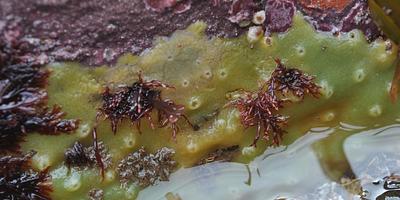
Breadcrumb Sponge
Halichondria panicea
What do they look like?
Ranging from olive-green to cream in colouration, Breadcrumb sponges come in multiple forms encrusting seaweed and hard substrates. It can appear very flat or it can look bumpy with volcano-like chimneys called “osculae”. In sheltered locations, it can grow up to 20cm thick and in areas with strong currents it has been known to span several meters in diameter. All forms have a grainy texture that looks a little bit like wet breadcrumbs. Breadcrumb sponges inhabiting shallow areas are more likely to appear green due to the presence of symbiotic algae in their tissues, whereas those inhabiting deep, shady water are more likely to be cream or yellow. They will also appear yellower in winter.
Where can I find them in Scotland?
Most common on open, tideswept areas of coast but can be found across the whole of Britain and Ireland. On the shore, they inhabit damp areas such as rockpools, boulders or underneath overhangs.
